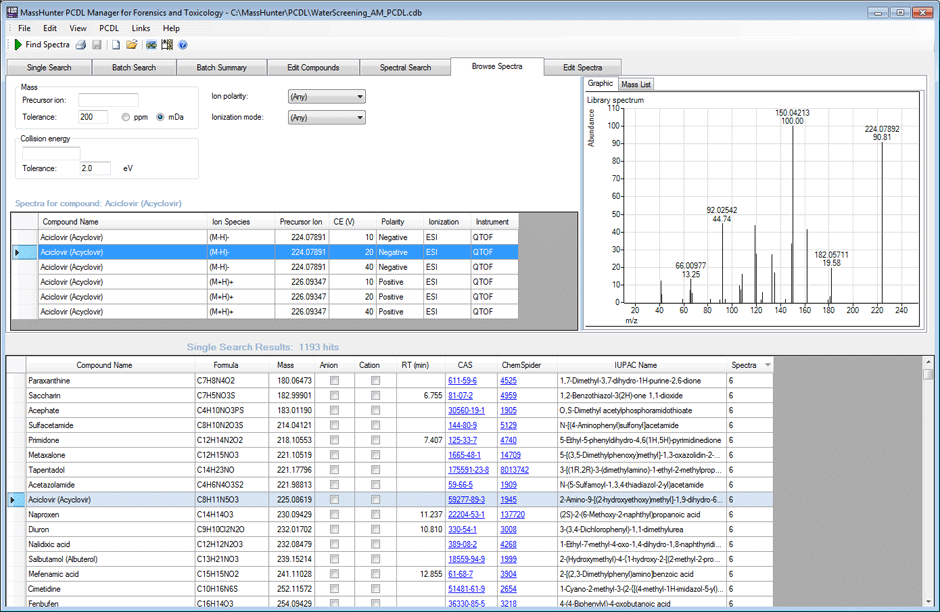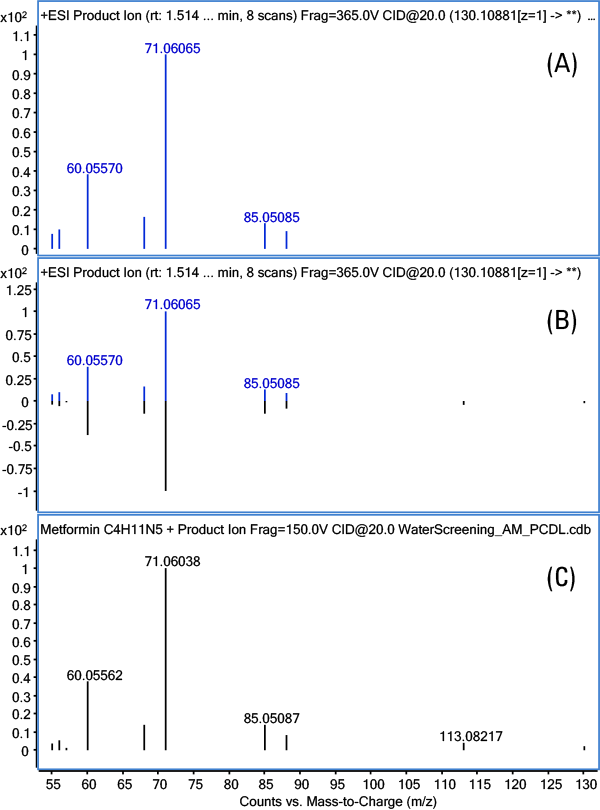Access Agilent eNewsletter June 2016

Agilent comprehensive water screening solution reliably identifies wastewater contaminants of emerging concern: A real-life application
Thomas Glauner, Agilent Senior LC/MS Applications Scientist
Universal access to potable drinking water in industrialized countries is one of history’s great public health achievements. Clean raw water sources are the prerequisite for high quality potable water. As a result, water monitoring is increasingly focused on screening for contaminants beyond the regulated target compounds. This is also reflected in broader and more stringent environmental regulations in the US and EU. The additional compounds are often anthropogenic high volume chemicals like pharmaceuticals and personal care products (PPCPs), agricultural chemicals, and transformation products thereof, many with poorly defined and potentially adverse effects on human health. Most environmental contaminants enter surface water via effluents from wastewater treatment plants (WWTPs), since they often are not fully eradicated by existing wastewater treatment methods.
This article describes how an Agilent UHPLC system coupled to a high-resolution, quadrupole time-of-flight (Q-TOF) LC/MS system was used to screen for environmental contaminants in effluent samples from four WWTPs in Switzerland. Enabled by the new Agilent LC/MS Water Screening Personal Compound Database and Library (PCDL), the analysis evaluated a wide range of compounds regulated under the EU Water Framework Directive (WFD) as well as a broad range of additional potential water contaminants with a high degree of confidence.
Applying the Agilent LC/MS water screening workflow solution
Agilent’s MassHunter LC/MS Water Screening Personal Compound Database and Library (PCDL) data were used for the broad screening of WWTP effluents. The curated PCDL contains more than 1,400 LC/MS amenable compounds currently regulated in the US, EU, Japan and China, plus emerging contaminants such as PPCPs and other contaminants previously detected in the environment or likely to be detected due to their widespread use.
Effluent samples from four WWTPs were analyzed, representing a variety of treatment methods, catchment areas, and service populations. Samples were collected during nine 14-day periods from March to June, covering the main pesticide application period.
Using the Agilent LC/MS system and PCDL, two screening workflow strategies were used to evaluate sample effluents from the WWTPs: target screening and suspect screening. Target screening was performed using the Agilent All Ions MS/MS technique for the analysis of the effluent samples and comparing approximately 390 compounds directly against a reference standard. A Find by Formula algorithm was used as a data-mining tool with the Water PCDL as the formula source. In combination with the All Ions methodology positive identification of target and suspect compounds was made based on a co-elution scoring of precursor and fragment ions.
This approach also holds true for suspect screening when the Agilent All Ions MS/MS method is used to identify compounds for which no reference standards were available. Suspected contaminants were tentatively identified with a high confidence by comparing accurate mass and isotope patterns, and co-eluting MS/MS fragments based on spectral data from the PCDL.

Figure 1. Agilent MassHunter PCDL Manager software showing the accurate mass MS/MS spectrum of the anti-viral drug aciclovir (acyclovir), acquired in negative ionization mode with a collision energy of 20 V.
Target screening results
Target screening identified a large number of environmental contaminants which were quantified based on reference standards. Pharmaceutical residues dominated the effluents of the larger WWTPs, which served relatively large populations. A total of 33 pharmaceuticals and their metabolites were identified in the effluents of the four WWTPs. These included widely used pharmaceuticals such as metoprolol, diclofenac, ibuprofen, naproxen, and metformin. Figure 1 shows the MassHunter PCDL Manager software with the accurate mass MS/MS spectrum of the anti-viral drug acyclovir.
A total of 46 pesticides and herbicides were also detected in samples from the four WWTPs. These included azoxystrobin, DEET, linuron, metamitron, methomyl, metribuzin, spiroxamin, and terbuthylazine. Pesticides were found most often and in the highest concentrations in the effluents of a plant with an agriculturally dominated catchment area.

Figure 2. An overlay of the molecular ion chromatogram for the anti-hypertensive drug valsartan (view A), identified from an effluent sample. The coelution plot (B) and compound identification results including coelution scores (C) are also shown.
Suspect screening results
In addition to the compounds included in the reference standards and analyzed in target screening, effluent samples were analyzed for all remaining compounds included in the Water Screening PCDL in a broad suspect screen. Using the Find by Formula algorithm, the Agilent Water Screening PCDL provided precursor formula information for which chromatograms were extracted. When reference spectra were available in the PCDL, chromatograms for the most abundant fragments were overlaid for identification and a co-elution score was calculated. Figure 2 shows the chromatograms for the angiotensin receptor blocker valsartan in the effluent of treatment plant that served a smaller population, as an example. Identification with a high level of confidence was achieved when the extracted ion chromatogram of the molecular ion and at least one or two fragments show perfect co-elution (co-elution score >90 out of 100) and the mass accuracy for the peak spectrum for both molecular ions and fragments was better than 5 ppm. Using this standard, other PPCPs were identified including candesartan, irbesartan, losartan, clarithromycin, fexofenadine, sitagliptin, celiprolol, clopidogrel, and phenylbenzimidazole sulfonic acid. In addition, nine further pesticides and organophosphates were found.

Figure 3. Comparison of the accurate mass MS/MS spectrum of metformin measured in an effluent sample with target MS/MS acquisition (view A) with the reference spectrum from the Agilent MassHunter LC/MS Water Screening PCDL (view C). A mirror representation of the difference is shown in view B.
Further confidence in the identification can be achieved when acquiring accurate mass MS/MS spectra combined with an MS/MS library search. Figure 3 shows the comparison of the acquired accurate mass MS/MS spectrum for the antidiabetic drug metformin in the effluent of a waste water treatment plant compared to the reference spectrum from the Agilent Water Screening PCDL. Even though metformin has a low mass molecular ion and even lower fragment masses, a library match score of 95.4 was observed, which confidently identified the presence of metformin.
Commercial and public health relevance
The Agilent LC/MS Water Screening Workflow Solution enables screening with a high degree of confidence for a wide range of known and suspected water contaminants. Agilent PCDLs can be customized and their content expanded as new compounds of interest are identified. The All Ions acquisition capability of the Agilent Q-TOF platform allows untargeted acquisition of precursor ions and fragments for a virtually unlimited number of compounds. Co-elution scoring based on fragment information from the Agilent PCDL MS/MS spectra allow for a presumptive match without having to use a reference standard. Retrospective analysis enables data to be re-analyzed or mined at any time, without reruns, to investigate samples for newly emerging contaminants. Contaminant screening of effluents from WWTPs can also reveal seasonal patterns of contaminant release as well as information about the collection area and the efficiency of the treatment process utilized by individual plants.
The Agilent LC/MS Water Screening Workflow Solution allowed the WWTPs to perform truly comprehensive screening of known contaminants as well as emerging PPCPs and other compounds in an environmentally sensitive industry, potentially avoiding adverse public health consequences. To learn more about Agilent water analysis solutions contact your Agilent representative today.
For Research Use Only. Not for use in diagnostic procedures. Information subject to change without notice.
Stay informed about the applications that are important to you
Subscribe to Access Agilent
Our free customized
monthly eNewsletter
All articles in this issue
 New Agilent 8900 ICP-QQQ delivers increased sensitivity, improved accuracy, and higher productivity
New Agilent 8900 ICP-QQQ delivers increased sensitivity, improved accuracy, and higher productivity New Agilent 1260 Infinity II LC system delivers higher level of operational efficiency
New Agilent 1260 Infinity II LC system delivers higher level of operational efficiency Robust Agilent 6470 Triple Quadrupole LC/MS delivers confident quantification and streamlined workflows
Robust Agilent 6470 Triple Quadrupole LC/MS delivers confident quantification and streamlined workflows Achieve accurate analysis of sulfur and nitrogen with the new and simplified Agilent 8355 SCD
Achieve accurate analysis of sulfur and nitrogen with the new and simplified Agilent 8355 SCD Agilent 1290 LC and 6550 iFunnel Q-TOF combine to provide fast, high-resolution peptide mapping of innovator and biosimilar mAbs
Agilent 1290 LC and 6550 iFunnel Q-TOF combine to provide fast, high-resolution peptide mapping of innovator and biosimilar mAbs Agilent collaborates with Academia—from investigating arsenic mysteries to understanding the complexity of biology
Agilent collaborates with Academia—from investigating arsenic mysteries to understanding the complexity of biology Excellent inertness for analysis of challenging polar compounds
Excellent inertness for analysis of challenging polar compounds Detection of semivolatile extractables and leachables (E&Ls) found in pharmaceutical products
Detection of semivolatile extractables and leachables (E&Ls) found in pharmaceutical products Agilent multi-omics solutions unravel the effects of low-level gamma radiation on rice seeds
Agilent multi-omics solutions unravel the effects of low-level gamma radiation on rice seeds Agilent comprehensive water screening solution reliably identifies wastewater contaminants of emerging concern:
Agilent comprehensive water screening solution reliably identifies wastewater contaminants of emerging concern:
A real-life application
Figure 1

Agilent MassHunter PCDL Manager software showing the accurate mass MS/MS spectrum of the anti-viral drug aciclovir (acyclovir), acquired in negative ionization mode with a collision energy of 20 V.
Figure 2

An overlay of the molecular ion chromatogram for the anti-hypertensive drug valsartan (view A), identified from an effluent sample. The coelution plot (B) and compound identification results including coelution scores (C) are also shown.
Figure 3

Comparison of the accurate mass MS/MS spectrum of metformin measured in an effluent sample with target MS/MS acquisition (view A) with the reference spectrum from the Agilent MassHunter LC/MS Water Screening PCDL (view C). A mirror representation of the difference is shown in view B.